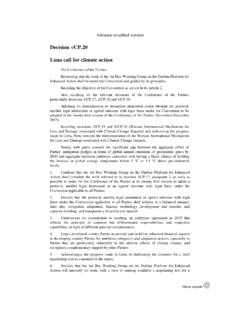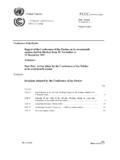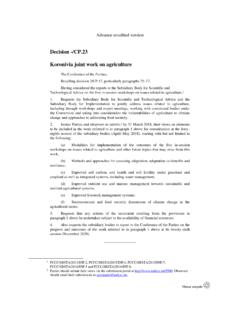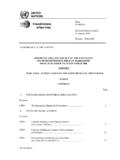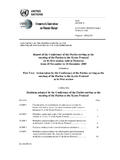Transcription of Technologies for Adaptation in the Agriculture Sector
1 Agriculture represents the single most important Sector in the economy of many low-income countries, and 75 per cent of the world s population is engaged in related activities (UNFCCC, 2006). In acknowledgement of the Sector s vulnerability to climatic impacts (IPCC, 2014), countries have prioritised Agriculture as a critical focus for climate change Adaptation . Technologies are often highlighted as a crucial resource for ensuring effective Adaptation in Agriculture . Their role has been emphasised in the Fifth Assessment Report of Working Group Two of the Intergovernmental Panel on climate change (IPCC WGII AR5) (IPCC, 2014), and the Agriculture Sector has been prioritised by 84 per cent of Parties in their Technology Needs Assessments (TNAs) (UNFCCC, 2013).The Technology Executive Committee (TEC) has recognised the need for appropriate policies to support countries in applying Adaptation Technologies to meet the objectives of the United Nations Framework Convention on climate change (UNFCCC).
2 This brief has primarily been developed for policy makers within national and local government institutions. It draws upon lessons learned from various relevant experiences and provides recommendations for policy makers, incorporating consideration of the principles of effective Adaptation (outlined in Section C-1 of the Technical Summary of the IPCC WGII AR5) and TNA recommendations for practitioners and policy makers (highlighted in the United Nations Environnent Programme s TNA Guidebook on Technologies for climate change Adaptation in the Agricultural Sector ). Similarly, the water Sector has been prioritised as a focus for policy development and a separate policy brief for this Sector can be referred to for further understanding of the symmetries, co-benefits and integration between the two for Adaptation in the Agriculture SectorWhy this TEC Brief?
3 TEC Brief #4 Technology Executive CommitteePhoto: C. Schubert (CCAFS) - Edward Ouko s climate -smart farm site in Western NationsFramework Convention onClimate ChangeTechnology Executive CommitteeTechnologies for Adaptation in the Agriculture sector2 Executive Summary This policy brief is intended for policy makers in national and local government institutions The brief addresses the application of Adaptation Technologies in the context of Agriculture , highlighting lessons learned, identifying examples of agricultural Technologies and their suitability, enablers and barriers, outlining the roles of stakeholders and offering recommendations for policy formulation. The contribution of Agriculture to local and national economies, food security and sustainable livelihoods, requires successful and sustainable Adaptation supported by appropriate Technologies .
4 Technologies in Agriculture enhance resilience to climate change and can offer co-benefits of Adaptation and mitigation. Experience has highlighted the need for collaboration, communication, and contextual appreciation to ensure that the Technologies introduced are appropriate. Appropriate policies at multiple scales are needed to sensitise planners to consciously factor in climate change mainstreaming to ascertain that future agricultural practices sustainably support the growing global population in the face of a rapidly changing UNFCCC (2005) defines Technologies for Adaptation as the application of technology in order to reduce the vulnerability, or enhance the resilience, of a natural or human system to the impacts of climate change . Applying Technologies for Adaptation is a complex process that requires the integration of multiple issues, stakeholders and scales.
5 The appropriate application of Technologies demands consideration of the particular political, economic, social and ecological context. This process may include consideration of approaches, through which to link multiple factors, which could include: accounting for diversity and maximising co-benefits; promoting the employment, development and transfer of hard and soft Technologies , including knowledge; and developing platforms for knowledge and sharing of experiences (UNFCCC, 2014d). In the context of Technologies for Adaptation in Agriculture , it may involve identification and assessment of agricultural practices and Technologies that enhance productivity, food security and resilience in specific agro-ecological zones and farming systems (UNFCCC, 2014a).On the other hand, it has been also noted that poor planning, alongside failure to consider long-term outcomes, potential climatic change and Adaptation limits can result in maladaptation or, an Adaptation that does not succeed in reducing vulnerability but increases it instead (IPCC, 2001: 378).
6 In less developed countries, technological application is supported by various processes and institutional arrangements. Support on technology include Technology Needs Assessments (TNAs), which identify, prioritise and highlight technology needs, and Technology Action Plans (TAPs), which are developed on the basis of TNAs to address specific barriers, and identify targets, strategies, budgets and responsible stakeholders for prioritised Technologies (UNFCCC, 2013). Examples of TAPs that specifically address agricultural Technologies in-clude those of Cote D Ivoire, whose TAP supports the increase of water-tolerant plantain and cassava varieties; Kenya, which prioritises the development of drought-tolerant sorghum varieties; and Sri Lanka, where the 1 Technologies for AdaptationTechnology Executive CommitteeTechnologies for Adaptation in the Agriculture sectorUnited NationsFramework Convention onClimate Change3focus is on the diversification of crops and site-specific crop management.
7 Global support in financing include financial provisions accessed from the Least Developed Countries Fund (LDCF) and the Special climate change Fund (SCCF), which prioritise the agricultural Sector each allocating it over a quarter of their budgets (UN-FCCC, 2014c). These supports are strengthened through the work of the UNFCCC s Adaptation Committee, Technology Mechanism (including the TEC and the climate Technology Centre and Network) and other bodies under the applying Technologies for Adaptation , the significant synergies, trade-offs and co-benefits with mitigation should also be considered. In the context of agricultural Adaptation , co-benefits are exemplified through health benefits from improved energy use, reduced urban energy and water consumption achieved via greening and recycling activities, sustainable Agriculture , and the protection of ecosystems and, consequently, the benefits derived from these ecosystems (IPCC, 2014).
8 Such an example can be seen from the introduction of manually-operated pressure irrigation pumps in Africa, which raise living standards, support Adaptation , and reduce greenhouse gas emissions, in comparison with use of fossil fuel-operated pumps (UNFCCC, 2014c). Another example comes from Bangladesh, where waste-to-compost projects aid Adaptation by improving soil in drought-prone areas, whilst also contributing to mitigation through the reduction of methane emissions (IPCC, 2014). Box 1. Complementarity of hard-, soft-, and org- wareTechnologies are often classified into three types: hardware, software, and orgware. In considering Adaptation , it is important to understand the differences between these technology types, as well as their synergies and complementarities. Hard Technologies , or hardware, refer to physical tools; soft Technologies , or software, refer to the processes, knowledge and skills required using the technology; and organisational Technologies or orgware, refers to the ownership and institutional arrangements pertaining to a technology (Christiansen et al.)
9 , 2011, UNFCCC, 2014b). In the agricultural context, hardware is exemplified by different crop varieties, software by farming practices or research on new farming varieties, and orgware, by local institutions that support the use of agricultural Adaptation Technologies . Whilst hard and soft Technologies are often introduced in isolation, it has been recognised that their simultaneous integration with orgware is necessary for success in Adaptation (Christiansen et al., 2011; UNFCCC, 2013; UNFCCC, 2014b). An example of technological innovation that includes all three types of technology can be found in the adoption of water harvesting Technologies in the Sahel. In the early 1980s, farmers here developed methods of rehabilitating degraded land by improving soils in their traditional planting pits, known as za , which consist of hoeing small holes into the soil, into which farmers put small amounts of manure and plant sorghum and millet (Ouedraogo and Sawadogo, 2005).
10 The pits concentrate water and nutrients precisely to where they are needed, and retain water for a long time, allowing plants to better survive dry spells and thus help to rehabilitate degraded land. The seeds or trees grown in the pits can be considered hardware, the practices around creating the pits and improving the fertility of their soil are software, and the farmer-to-farmer field schools used to share the information with thousands of farmers across the region represent orgware. Though all three technology types are necessary, there is a concern that hard Technologies are currently prioritised and often employed in isolation (Christiansen et al., 2011; UNFCCC, 2014b). Countries require encouragement and assistance in implementing all three technology types in a mutually supportive manner, in order to ensure sustainable and effective application of Technologies for Adaptation in the Agriculture NationsFramework Convention onClimate ChangeTechnology Executive CommitteeTechnologies for Adaptation in the Agriculture sector4subsequently adjusted seed use and cropping techniques, in order to ensure suitability to each context (Bentley and Thiel, 2008).


